June 20, 2012
So we started with rain. No big deal. We plod on, even if the mistiness
sort of made it hard to appreciate the view on top of the hilly
vine-growing region.
The rain more or less mellowed into a persistant drizzle by the time we
reached Domaine Perraud's winery. The winery itself is new, a shiny
silver oblong in the middle of clay and limestone and grapevines. The
plot of land, I believe, is old, and has 30-year-old vines. We were
given a tour around the vineyard by the lovely Sonia.
 |
| Sonia in full lecture-mode on vine-growing |
 |
| Poppies and wildflowers. Not grapevines or anything, but still very pretty |
Burgundy grape varieties are planted on hill slopes for good drainage, as we saw thanks to the rain.
 |
| Limestone. The Burgundy grape varieties, Pinot Noir and Chardonnay, thrives on well-drained clay-limestone soil |
 |
| Grapevines! |
 |
| More grapevines |
 |
| Budding baby grapes |
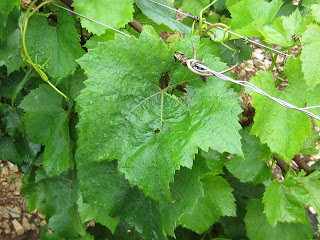 |
| Grape leaves |
 |
| Grapevine buds |
 |
| More grapevines |
 |
| Haha tourist |
 |
| What caused this I wonder? |
 |
| Little seedlings. They will be used to replace any dead or dying old vine. |
The facility sports some modern equipment, like the grape-presser that
uses an inflatable balloon within a cylindrical metal hull that will
press the grapes. The balloon will not press the grape too hard that the
seeds break and release undesired flavors into the
juice-that-would-be-wine. The juice is then fermented in either large
steel vats or oak barrels. The barrels will add to the flavor, but
oakiness is not exactly desired in Burgundy wine. Sonia buys her oak
barrels second-hand.
 |
| A modern grape-presser with an inflatable balloon to press the grapes. |
 |
| Large steel fermentation vats. |
 |
| Oak barrels |
There was wine in the oak barrels, which we understandably got excited
over. We were invited to hear the 'crackling' (release of carbon dioxide
gas bubbles from alcoholic fermentation via yeast) in the barrels,
which was as close to a spiritual wine experience as I can get.
The wines are tasted twice a day (if I remember correctly), one first
thing in the morning and another one, later. Then again, I might be
confused with cow or goat milking, but I'm pretty sure the wine is
tasted more than once. The sediments in the barrels are also stirred to
rile up the yeast and add to the flavor.
We then got to taste some of the fermenting wine, which were cool, fresh, and crisp.
 |
| There is wine in there |
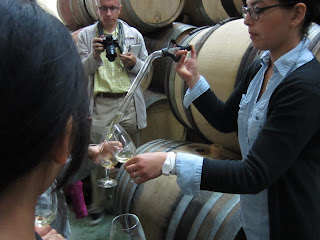 |
| Sampling the wine. Note the great big wine pipette. |
 |
| This was heavenly |
The wine made way to our little Wednesday picnic, with an assortment of cold cuts and cheeses and Domaine Perraud wines.
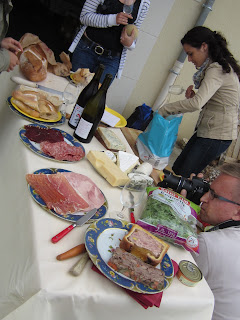 |
| Our picnic spread |
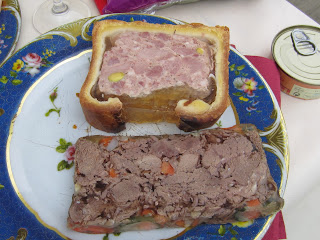 |
| Pâté |
The truffle potato chips Sonia provided deserve a mention.
 |
| Tentative tasting of truffle chips |
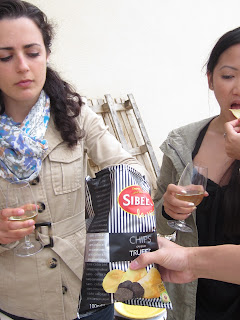 |
| Notice how everyone seems very uncertain about these chips |
 |
| Wei Jie was particularly excited. They were truffel potato chips, after all. |
 |
| My bread with the knob at the end. |
We headed off to the Bourdon goat farm and goat-cheese fromagerie next, with a little intermission involving admiring lichen:
 |
| I mean, it is after all, microbiology |
 |
| These are amazing |
The Bourdon
Chevrerie or goat farm is a small little
establishment that makes award-winning goat cheese and has a bed and
breakfast in what used to be a pigeon house. It was a pigeon house.
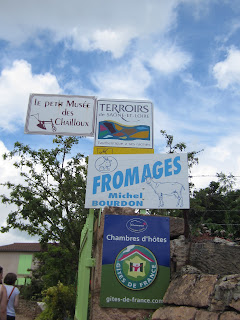 |
| Chevrerie Bourdon |
 |
| Random flower shot, because the place was full of it and it was beautiful |
 |
| 'For the cheeses....' |
 |
| A view of the place. The thick clouds makes it look rather dramatic |
 |
| The Bourdon house |
 |
| The view! |
 |
| Goats! |
 |
| Goat |
We were brought to the farming museum by Mr and Mme Bourdon. The museum
was a collection of old farming tools, which included a fully wooden
plough and its descendant, a metal plough with heavy chains. These would
have been driven by draught horses (draft horses is the American way to
say it, apparently). I almost typed water buffalo, because that's what
farmers in Malaysia use. The thought of the ploughs reminded me how much
buffaloes were prized in Malaysia. Other interesting tools were the
triangular goat collars - basically triangular wooden frames draped
around a goat's neck to prevent it from moving through hedges - and a
big red machine on wheels that I never found out did what.
 |
| The certificates for the award-winning cheeses |
After a brief introduction on goat cheese-making by Mme Bourdon, we were
invited to sample some of the goat cheeses of varying stages of
affinage.
 |
| Our wine and cheese spread |
I honestly love goat cheese. I have never had one in my life until that
Sunday when we arrived in Cluny. I've only tasted goat milk a few days
before leaving Malaysia. Among the different-aged cheeses, I cannot
determine which I love the most; the fresh cheeses, left to age for
about a day, were creamy and mild; the older ones, perhaps about three
months, were harder and more flavorful; the oldest, six months at least,
I think, had a bluish-grey growth of penicillium that made it more
exciting, and were flaky. Though at a glance the moldy cheese would look
as appetizing as an old shoe, it tasted amazing. When I was younger I
had avoided blue cheese. It did not sit well with me, eating cheese with
a fungus growing on it. A
fungus. Then again, Malaysian cheese
were those processed, neat slices, so it pays to go out and try new
things. Moldy cheese (intentionally moldy) are perhaps now one of my
favorite types of cheese.
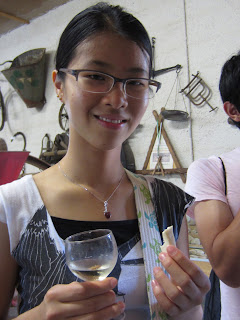 |
| I am very happy with the amount of cheese and wine I am consuming |
We were too full from the picnic to eat more cheese, which was a shame because they were great.
We managed to get a glance of the cheese lab where the cheeses are made and aged.
 |
| The cheese lab |
 |
| French signs. I need to work on my French reading skills. |
We were also brought to the place where they kept and milked goats.
Since I was first introduced to pungent goat cheese before the goats
themselves, I was inclined to think that the goats smelled like goat
cheese than the reverse.
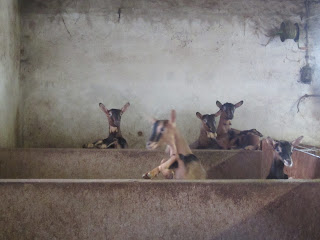 |
| The goats were very excited to see us too |
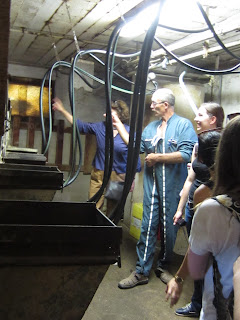 |
| The milking contraption |
 |
| All farms would have flies. Flypaper comes in handy. |
I do not really want to describe much about the head monk's Summer
house, the château de Berzé, but here are some nice pictures of them.
Although we could not take pictures of the wall paintings, they were
impressive, and perhaps were the same kind that once adorned the Cluny
abbey. A quick Google search of Bérze-la-Ville will yield some pictures.
 |
| Horses |
It's nice to have castles made of stone. Old Malaysian palaces and
structures were made of wood (save the Portugese A Famosa in Malacca) so
they are long gone.
-
Louisa Lee
